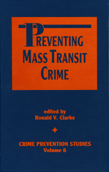
Crime Prevention Studies, Volume 6
Edited by Ronald V. Clarke
This paper examines whether crime and deviance declined within New York City's Port Authority Bus Terminal as a result of modifications made inside. This sprawling, busy facility underwent numerous small but strategic changes in design and management, mostly in 1991 and 1992. This effort combined situational prevention with Crime Prevention through Environmental Design, the latter approach involving the design of many environmental details within a comprehensive plan. Although the data are not perfect, they indicate that the Port Authority made this huge transit complex much less of a crime generator, crime attractor and fear generator. These changes also suggest a "stop-and-go" theory of how human movement patterns relate to the decisions to commit criminal acts.
During the late 1980s and early 1990s, international toll fraud at the pay phones of the Port Authority Bus Terminal in Manhattan was an entrenched criminal enterprise involving millions of dollars per year. People wanting to call outside the U.S. could make contact with a "hustler" at the terminal who knew how to obtain illegal access to toll lines, and who would connect the call for them for a fraction of the usual cost. This business helped to attract many criminals to the building, and toll fraud materially contributed to the terminal's unsavory atmosphere. It proved highly resistant to police action and was only eliminated during a comprehensive effort by the management to rid the building of crime. Various measures recommended by two separate groups of consultants were implemented, including a reduction in the number of pay phones, restricting access to high-risk pay phones outside rush hours, removing the phones' international dialing capacity and disabling the telephone keypads to prevent the routing of fraudulent calls through the exchange systems of private businesses.
This paper evaluates the effect of the installation of "high-wheel" turnstiles on the incidence of fare evasion at a subway station in New York City. Ridership, summons and arrest data at the treatment station and two adjacent control stations suggest that the new high-wheel turnstiles were somewhat effective in reducing fare evasion, with little evidence of displacement. In light of these results, this article addresses the issue of whether the marginal success of these measures, which some say create a draconian, prison-like environment, justifies their detrimental effects on station aesthetics.
During April 1995, a bicycle-mounted security patrol was introduced into a vehicle-theft "hot spot," the largest park-and-ride commuter vehicle park in British Columbia. Vehicle thefts dropped substantially in the vehicle park during the bicycle patrol, and remained low for an extended period of time after the bike patrol was withdrawn. Vehicle thefts did not appear to displace to adjacent areas or to another nearby hot spot on the transit system. Some vehicle thefts may have been displaced to a more distant hot spot, but the overall result for the city as a whole was a small net reduction in vehicle thefts.
Most successful crime prevention efforts take the approach of "designing out crime" through the identification of highly specific crime problems and the development of preventive efforts to reduce them (Clarke, 1992). A study of the design, maintenance and management of "Metro," Washington, DC's subway system, allows for the novel approach of evaluating an effort to design in security at the outset. This paper examines the crime prevention characteristics of Metro's environment. It sets out a series of tests documenting Metro's success in keeping crime rates on the system at an unusually low level, and demonstrating that these low crime rates are explained by Metro's environment.
Design plans for Meteor, a projected new Metro line in Paris, provide the opportunity to compare its security features with those of the existing Paris Metro and two subway successes in Washington, DC, and Hong Kong. Meteor includes a wider range of situational measures than the existing Metros in Paris, Washington, DC, or Hong Kong, and its security features are consistent with the most recent developments in crime prevention strategies (Clarke and Homel, in press). If the projected design plans are properly implemented, Meteor promises to be a crime-control success.
Angel (1968) hypothesized that street robberies were more likely to occur at intermediate levels of pedestrian traffic and less likely to occur at either low or high levels. The present study examines this hypothesis using recent data on platform robberies and passenger densities for 206 stations in the New York City Subway. Contrary to Angel's contention, the incidence of subway robberies was found to be greater at low levels of passenger density. Reasons why these findings might not hold beyond the subway environment are discussed, and the implications for reducing subway robbery are explored.
In big cities, public spaces can be dangerous spaces, with predatory street crime concentrated in specific areas or pervading the community. In this study, the geographic distribution of street robbery in 1993-94 is compared in four Chicago police districts. In the two low-rate districts, street robbery was concentrated near rapid transit stations. In the two high-crime districts, although robberies were most likely to occur along main streets, almost every block had at least one street robbery during the two-year period. These two patterns of street robbery graphically illustrate bases both for opposition to and support for problem-oriented policing. Proponents of problem-oriented policing could argue that the general level of street robbery in lower-rate districts might be reduced by concentrating surveillance in the area surrounding rapid transit stations. In contrast, in higher-rate districts opponents of problem-oriented policing might argue that where the risk of predatory violence is high and widely dispersed, the root causes of crime-rather than their symptoms-must be attacked. Problem oriented policing may be of little use if poverty and lack of jobs, racism, deteriorating housing and family collapse must be ameliorated before predatory street crime can be reduced.